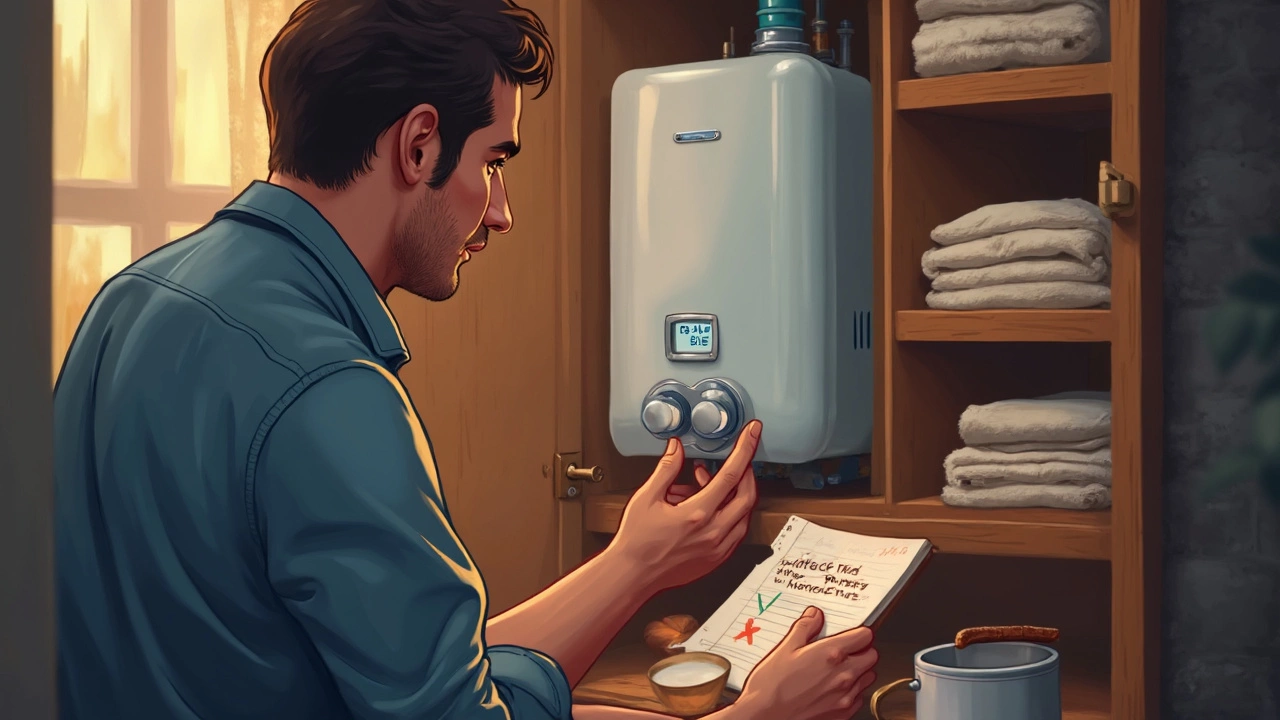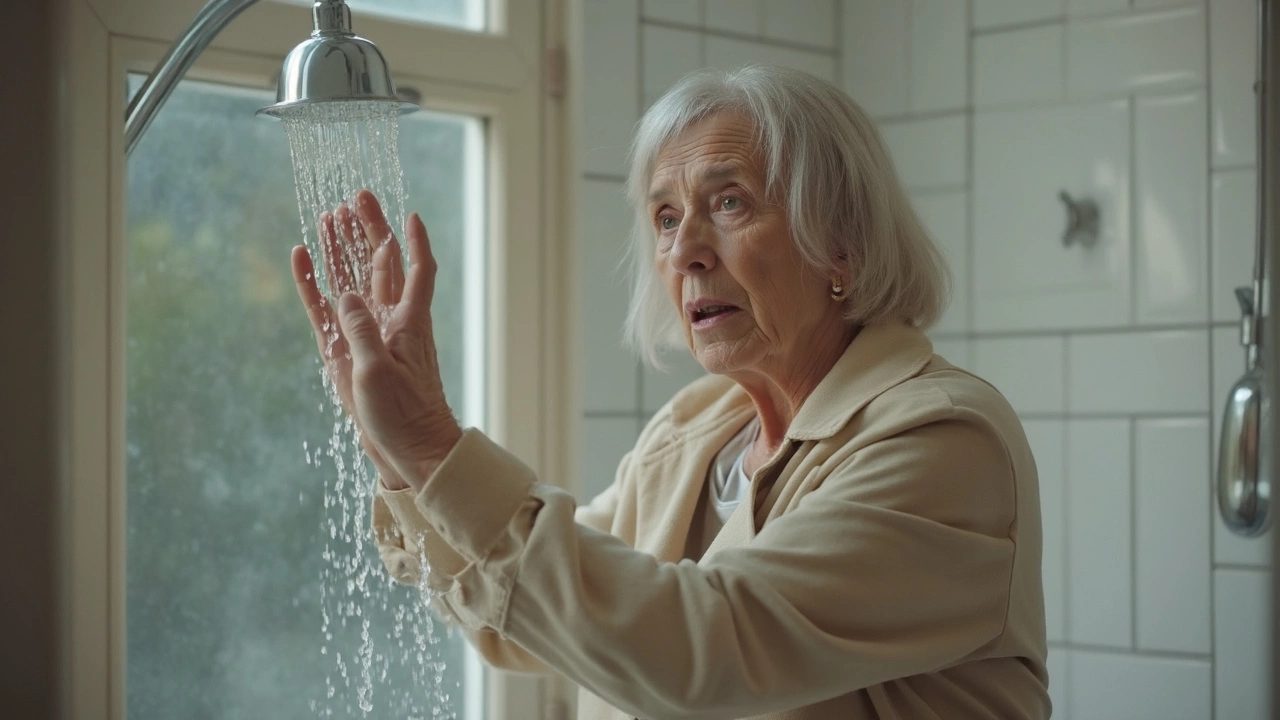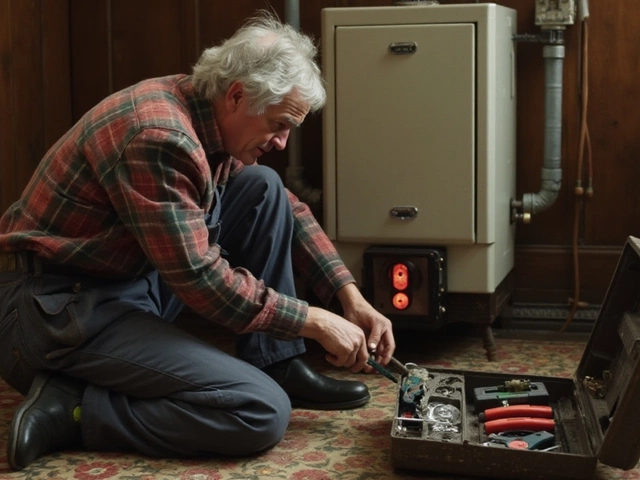Ever turned on the tap expecting a hot shower, only to get hit with cold water or scalding heat? Your water heater thermostat might be the villain. Most folks don’t even think about their hot water heater until something feels off, but the thermostat is actually one of the first things that can mess up your temperature balance.
Here’s a quick fact: Electric water heaters usually have two thermostats, one at the top and one at the bottom. If just one acts up, your water can swing from freezing to lukewarm or run out way too fast. Not fun when you just want a decent shower.
So, how do you spot a bad thermostat before you shell out for a new heater or call in a pricey repair guy? It’s a lot easier than you’d think, and you don’t need to be an electrician. We’ll break down the warning signs, walk through the simple tests, and give you straight-up tips to figure it all out without the stress.
- Spotting the Red Flags: Symptoms of a Bad Thermostat
- Quick Checks Before Blaming the Thermostat
- How to Test a Water Heater Thermostat Safely
- What to Do If Your Thermostat Is Really Fried
Spotting the Red Flags: Symptoms of a Bad Thermostat
If your hot water heater thermostat is going bad, it usually doesn’t keep it a secret. You’ll notice everyday annoyances that just won’t go away. Knowing what to look for can save you cash and headaches.
- Inconsistent water temperature: One day you get lukewarm water, the next it’s boiling. Or maybe the hot water keeps running out way faster than it used to. These are classic signs your thermostat is on the fritz.
- No hot water at all: If your tank isn’t making any hot water, it could be the upper thermostat. The top one controls the whole system, so if it fails, you’ll get nothing but cold.
- Water that’s too hot: If you’re jumping back from the tap not because of the cold, but because of scalding hot water, a stuck thermostat could be to blame. The heater doesn’t know when to stop heating.
- Breaker trips or resets a lot: When the thermostat doesn’t shut off, your water heater keeps pulling power. That’s rough on your electric system, sometimes tripping the breaker repeatedly.
To put things in perspective, about 30% of water heater service calls turn out to be traced back to thermostat issues. Here's a simple breakdown of common complaints homeowners mention and how often it’s a thermostat problem:
| Common Hot Water Problem | % Linked to Thermostat Issues |
|---|---|
| No hot water at all | 60% |
| Inconsistent temperatures | 50% |
| Water too hot | 40% |
| Breaker keeps tripping | 30% |
If you’re dealing with any of these symptoms, don't ignore them. A faulty water heater thermostat can ruin showers, waste energy, and even push your electric bill up. Catching it early keeps your hot water running smoothly and keeps you from shelling out more later.
Quick Checks Before Blaming the Thermostat
Before you go all in on replacing your thermostat, let’s make sure something simpler isn’t wrecking your hot water. Sometimes it’s not the thermostat at all, but a clogged pipe, tripped reset button, or just a blown fuse making you sweat (or shiver).
Start with the power. About 90% of water heater thermostat problems are actually just power hiccups. If the heater isn’t getting juice, no thermostat can save the day. Check your home's breaker panel. If you see the water heater breaker flipped, reset it and see if the heater kicks on again.
- Look for a red reset button (usually behind the heater's access panel). That button likes to trip if things get too hot or if there’s a wiring hiccup. Press it—if you hear a click, you might be back in business.
- Check your water supply valve. If the water heater isn’t getting water, it won’t heat what isn’t there. Make sure your shutoff is open all the way.
- If you turned the temperature dial down to save money, double-check that setting. Sometimes it’s just set too low (it should be around 120°F for most homes—anything lower might feel more lukewarm than hot).
Here’s a quick reference table with common things that trigger cold-water complaints:
| Issue | How to Check | Fix |
|---|---|---|
| No power to heater | Check the circuit breaker | Reset breaker |
| Tripped reset button | Open access panel, press button | Reset thermostat |
| Closed water valve | Inspect cold water shutoff | Open valve |
| Temperature set too low | Check thermostat dial | Increase setting to 120°F |
Sometimes sediment buildup in the tank messes with the heating elements, making it seem like your thermostat is faulty when it’s really just gunk slowing things down. If your water gets hot sometimes but not others, or your heater makes popping noises, draining the tank to clear out sediment could fix everything.
Always run through these simple checks first. Swapping out a thermostat isn’t rocket science, but if you skip these steps, you might spend money (and effort) fixing the wrong thing.

How to Test a Water Heater Thermostat Safely
First things first—safety comes before anything else. Water heaters run on 240 volts, which can give you a nasty shock if you’re not careful. Always switch off the breaker for your water heater in the main electrical panel. Double-check by trying to turn on hot water or using a voltage tester on the wires. If you see any lights or hear buzzing, power’s still on. Don’t take chances.
Once you’re sure the power’s off, grab a screwdriver and remove the metal panel on the side of your heater. There’ll be some insulation and probably a plastic safety cover. Move those aside until you see the thermostat and its wiring.
Now, here’s how to check if your water heater thermostat is the troublemaker:
- Study the layout. You’ll see either one or two thermostats (most electric heaters have two—one for the top, one for the bottom). Each one connects to a heating element.
- Set your multimeter to continuity or resistance (Ohms). If you don’t have a multimeter, many hardware stores sell cheap ones.
- Test for continuity. On most thermostats, use the probes to touch the two terminal screws. If you have continuity (the meter beeps or shows zero resistance), the thermostat is allowing power through, which is what it should do if it’s calling for heat. No continuity? That thermostat might be shot.
- Check the reset button. Some thermostats have a little red reset button. If it’s popped out, press it back in. If it keeps tripping, the thermostat could be bad, or there may be another issue like a faulty heating element.
- Compare readings for both thermostats. If one is working and the other isn’t, you’ve found your problem. Write down your results if you need to talk to a pro later.
Here’s a tip: Thermostats for electric heaters are cheap to replace (often under $25). If you’re unsure, swapping it out is a lot cheaper than hiring someone to come over. Just remember to always keep the breaker OFF whenever you're touching wires.
What to Do If Your Thermostat Is Really Fried
If you’ve figured out that your hot water heater thermostat is toast, don’t freak out. Swapping out a thermostat is way less scary than most folks think. In fact, it’s one of the easier fixes on a standard electric heater, and you don’t always need to bring in a plumber if you’ve got some basic tools and know how to follow simple steps.
Here’s what you need to do:
- Shut off power to the heater. Head to your breaker panel and flip the switch for your water heater to off. This is non-negotiable. Even pros take this step because getting shocked by 240 volts is serious business.
- Remove the access panels. Unscrew the little panels on your heater. You’ll see some insulation—pull it back to uncover the thermostat.
- Double-check for power. Use a non-contact voltage tester (about $15 at any hardware store) to make sure there’s no juice left in the wires.
- Take a picture of the wiring. You’ll want this for reference when you reconnect things.
- Disconnect the wires and pull out the old thermostat. Most just snap out of their slot—no need for fancy tools.
- Match the replacement. Bring your old model to the store so you get an exact match—thermostats aren’t always universal.
- Pop in the new thermostat, reconnect wires as you saw in your photo, and carefully push everything back in place.
- Put the insulation and panel back. Then flip the power back on at the breaker box.
- Test it. Wait about an hour, then run the water and see if you’re back to normal.
Here’s a little cheat sheet to help you remember what you’ll need and what steps to take:
| Item Needed/Step | Details |
|---|---|
| Replacement Thermostat | Match brand and type for your heater (top vs. bottom) |
| Screwdriver | Phillips or flathead, depends on your panel |
| Voltage Tester | Checks for live electricity (safety first!) |
| Camera/Phone | Take photos before detaching wires |
| Power Off? | Always double-check before touching wires |
If you replace the thermostat and nothing changes, the problem might be deeper—like a busted heating element or a wiring issue. In that case, it’s time to call a pro. But most folks find that swapping out a busted *water heater thermostat* gets hot water flowing again.
Quick tip: Don’t mix up the top and bottom thermostats. They play different roles, and using the wrong replacement can mean weird heating cycles or no hot water at all.







